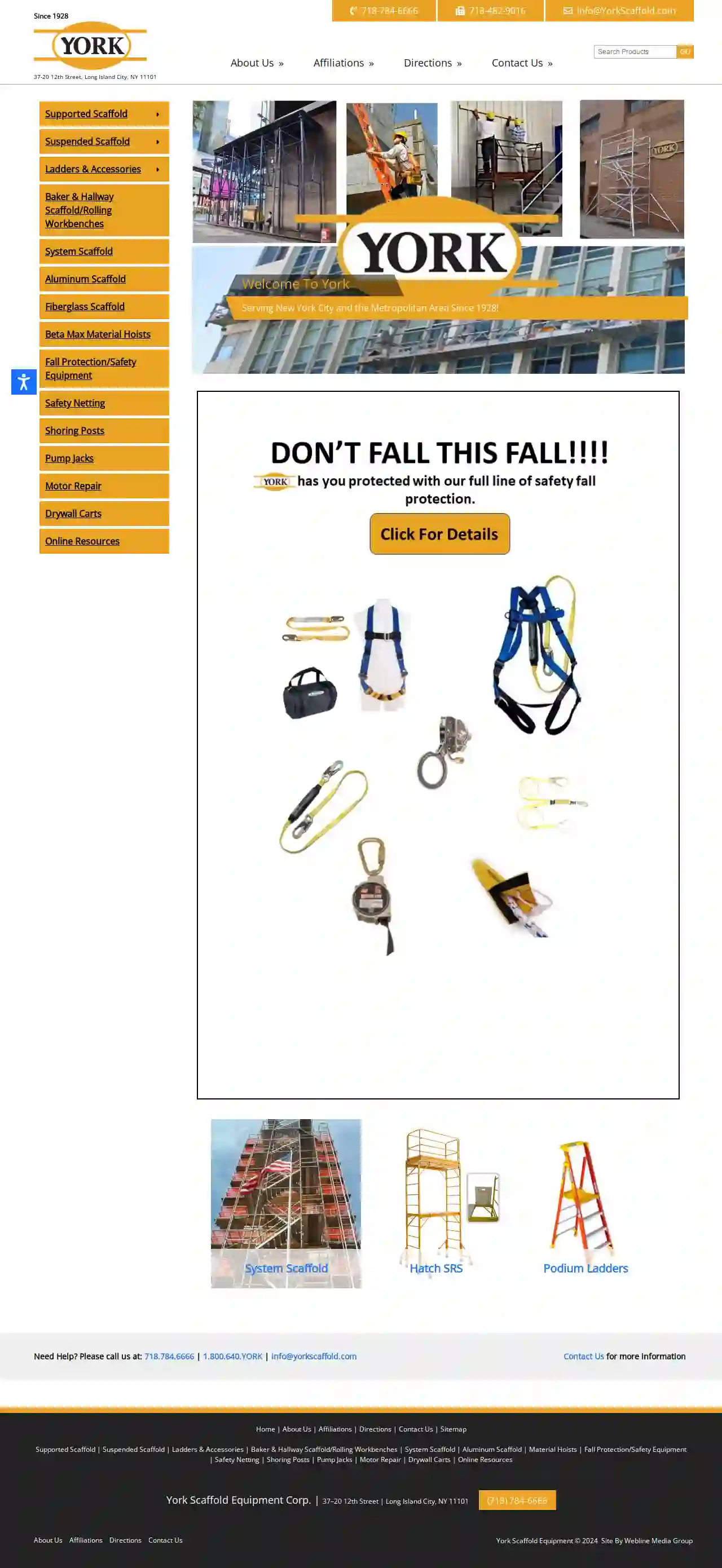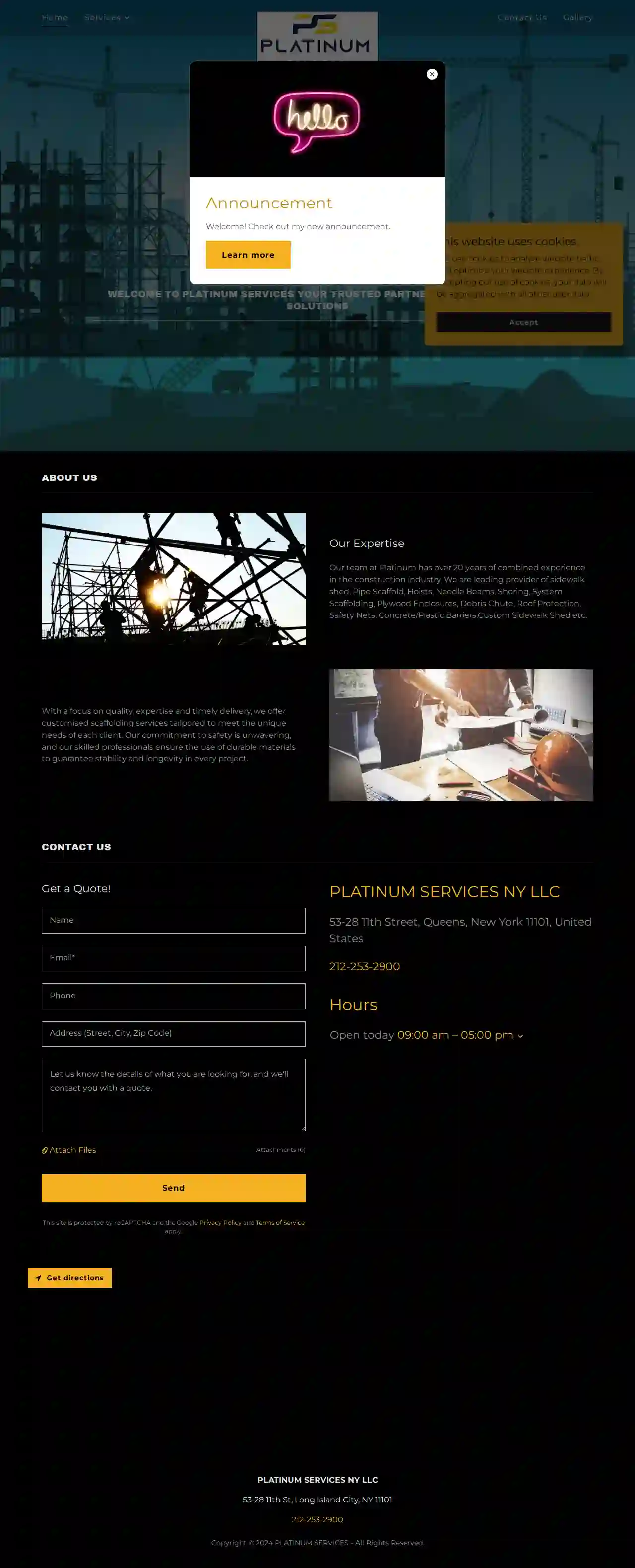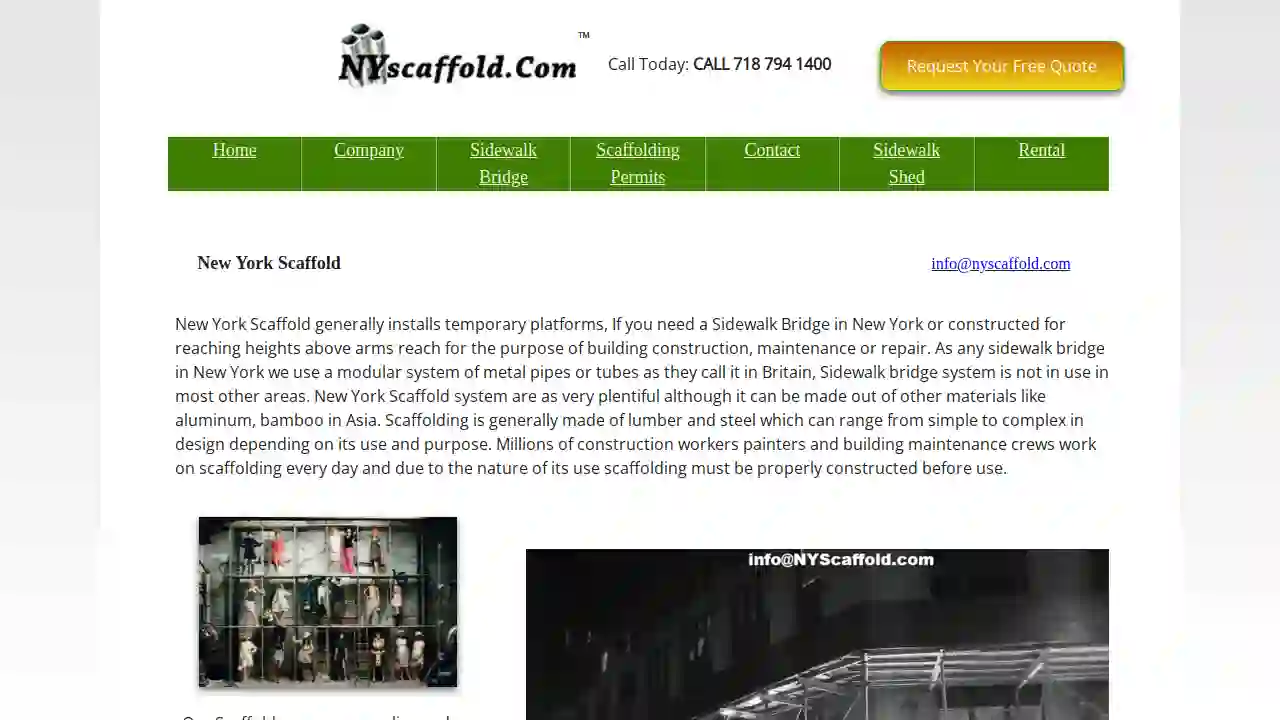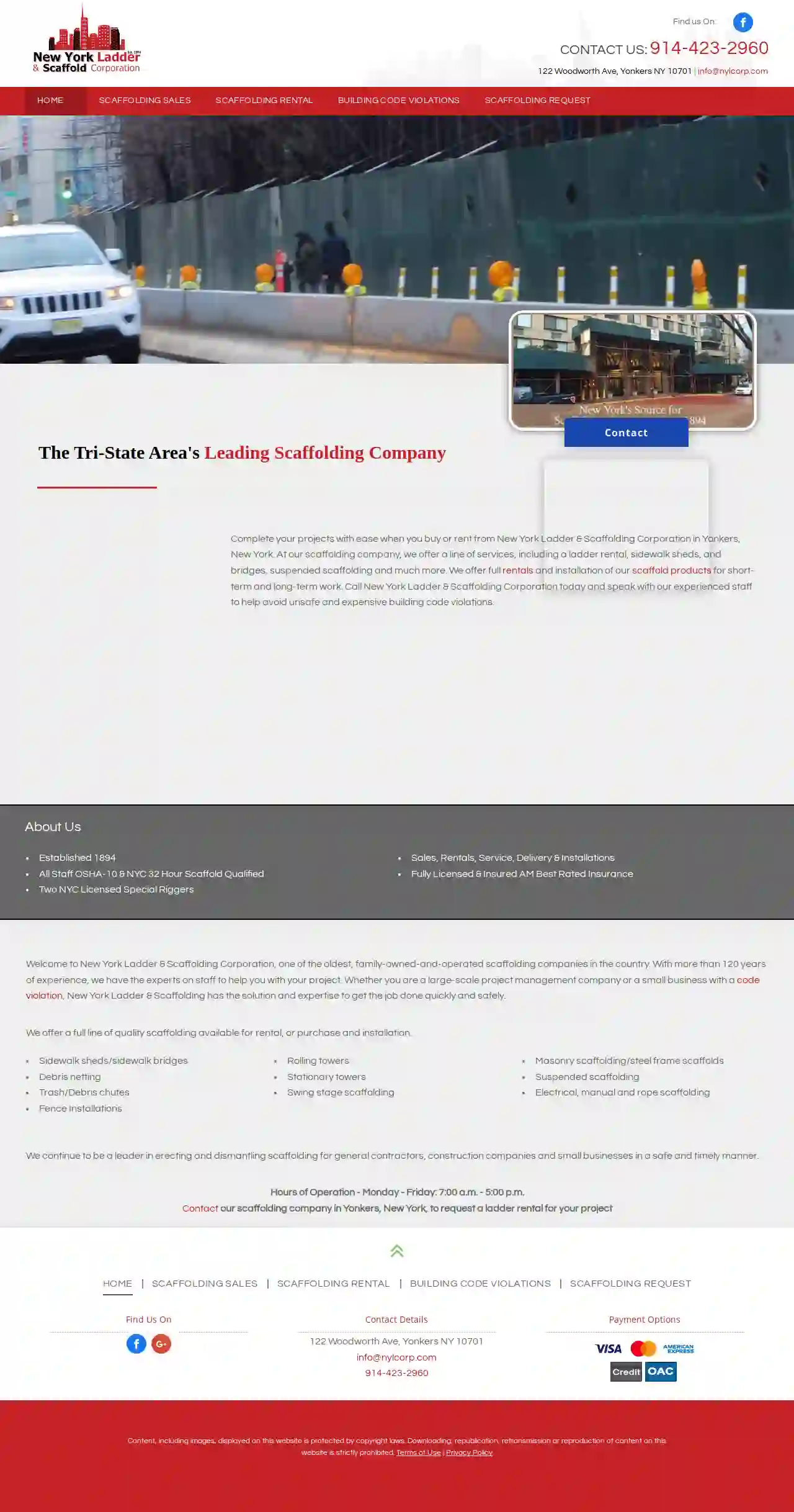Scaffolding Companies East Stroudsburg
Find Scaffolding Company in East Stroudsburg
Get 3 FREE Scaffolding Builders quotes for your project today! Compare profiles, reviews, accreditations, portfolio, etc... and choose the best offer.

Kings Group NY Corp
51 reviews120-5 Atlantic Ave, Suite #2, Richmond Hill, 11418, USAt Kings Group NY, we prioritize Safety and Quality in every project we undertake. Our mission is to ensure that our clients receive the best possible service, from the initial consultation to the completion of the project. With a team of experienced professionals, we provide top-notch scaffolding services to contractors, construction managers, developers, and building owners. Our organization is committed to meeting project budgets, schedules, and daily safety codes, and we take pride in our ability to deliver exceptional results. Our team is comprised of NYC DOB and OSHA code-certified professionals who are dedicated to providing the highest level of service. We offer a range of services, including sidewalk sheds, scaffolding, hoists, and other specialized services. Our goal is to provide our clients with the best possible experience, and we strive to exceed their expectations in every way.
- Services
- Why Us?
- Accreditations
- Gallery
Get Quote
Celtic Scaffolding Company
4.214 reviewsYork, USAt Celtic Scaffold, we specialize in providing top-notch scaffolding services to our clients in New York City. With years of experience in the industry, our team of experts is well-versed in the different types of scaffolds, including pipe scaffolds and hanging or suspension scaffolds. Our pipe scaffolds are stationary and constructed with pipes, erected from the ground up along the side of a building. We ensure that our pipe scaffolds comply with the regulations set by the Construction Division within each borough office of the Department of Buildings (DOB). On the other hand, our hanging or suspension scaffolds are supported from the roof or setback of a building and held by either cables or rope. We contract master riggers or special riggers for the work, and each worker using or operating the suspension scaffold must be employed by the master rigger, special rigger, or their company.
- Services
- Why Us?
- Gallery
Get Quote
York Equipment Corp.
4.628 reviewsLong Island City, NY, 37-20 12th Street, 11101, USYork Scaffold Equipment Corp. has been serving New York City and the Metropolitan Area since 1928. The company specializes in providing a wide range of scaffolding solutions, including supported, suspended, and system scaffolds, as well as ladders, accessories, and safety equipment. With a strong commitment to customer satisfaction and safety, York Scaffold Equipment Corp. offers top-quality products and services to meet the needs of construction and renovation projects.
- Services
- Why Us?
- Accreditations
- Our Team
- Testimonials
- Gallery
Get Quote
West New York Restoration of CT, INC
4.512 reviews1800 Boston Rd, Bronx, 10460, USWest New York Restoration of CT, Inc was founded in 1984 by Principal Alfred Gallicchio with the goal of providing high-quality contracting services in the field of exterior restoration, roofing and waterproofing. The philosophy of the company and its owner is a simple and direct one: to combine experience, management services, and skilled workforce to achieve the highest level of quality for each project. West New York Restoration of CT, Inc.'s key personnel bring a wealth of experience to each project. Whether the problem at hand concerns roofing, waterproofing, masonry, or structural repair, West New York Restoration of CT, Inc. can provide the solution.
- Services
- Why Us?
- Our Team
- Gallery
Get Quote
Platinum Services
34 reviews53-28 11th St, Long Island City, 11101, USWelcome to Platinum Services, your trusted partner in scaffolding solutions. With over 20 years of combined experience in the construction industry, our team at Platinum has the expertise to provide customized scaffolding services tailored to meet the unique needs of each client. Our commitment to safety is unwavering, and our skilled professionals ensure the use of durable materials to guarantee stability and longevity in every project. We offer a range of services, including sidewalk shed, Pipe Scaffold, Hoists, Needle Beams, Shoring, System Scaffolding, Plywood Enclosures, Debris Chute, Roof Protection, Safety Nets, Concrete/Plastic Barriers, and Custom Sidewalk Shed. Contact us today to get a quote and learn more about our services.
- Services
- Why Us?
- Gallery
Get Quote
NY Scaffold
51 reviewsYork, USWe are national scaffold contractors and scaffolding erectors. Experienced NY Scaffold erectors can provide a range of access services for you or your clients, we also take care of any and all NYC DOB Permits. Large and small projects; industrial, commercial and domestic sectors can hire the services of NY Scaffold erectors. No job is too big or too small for us and we have grown our business in the last few years to become one of the leading erectors of scaffolding and sidewalk bridges in the NYC area. Plan your project with complete confidence the sidewalk bridge company NYC can erect scaffolding to all types of structures. NYC installs scaffolds from access towers to bridges and any other type of access equipment that your firm might require. It does not matter how big or how small your project is NY scaffold company NYC will cater to your needs. They have secure access equipment that is perfect for projects in and around the region. Our Scaffolding has several unique safety features that benefit the system’s erectors, users and project inspectors. With eight completely variable component node points and the largest available bay sizes, Our Scaffolding offers the most flexible system. Only five main components are required for basic use and the only erection tools required are a hammer and level. The system’s optimum design offers a high load rating and extreme rigidity, keeping your workers secure and productive. NY Scaffold is the leading specialty Scaffold Erector Company covering the whole of the US. We are totally focused on customer satisfaction and pride ourselves on the range of services we provide, We have 95% repeat business on an ongoing basis. NY Scaffold is fully self-sufficient and one the largest stockholders of the sidewalk bridge system within the US. This forms the basis of the NY Scaffolds motto safety speed efficiency. Our business is based around the materials that are stored in bins and are loaded by forklift in our yards and unloaded on site by our Truck mounted Booms. We deliver our scaffolding equipment to your site, and our team of experienced erectors will set it up for you, ensuring that your project is completed safely and efficiently.
- Services
- Why Us?
- Gallery
Get Quote
New York Ladder & Scaffold Corporation
46 reviews122 Woodworth Ave, Yonkers, 10701, USWelcome to New York Ladder & Scaffolding Corporation, one of the oldest, family-owned-and-operated scaffolding companies in the country. With more than 120 years of experience, we have the experts on staff to help you with your project. Whether you are a large-scale project management company or a small business with a code violation, New York Ladder & Scaffolding has the solution and expertise to get the job done quickly and safely. We offer a full line of quality scaffolding available for rental, or purchase and installation. Our services include sidewalk sheds/sidewalk bridges, debris netting, trash/debris chutes, fence installations, rolling towers, stationary towers, swing stage scaffolding, masonry scaffolding/steel frame scaffolds, suspended scaffolding, electrical, manual and rope scaffolding. We continue to be a leader in erecting and dismantling scaffolding for general contractors, construction companies and small businesses in a safe and timely manner. Our hours of operation are Monday - Friday: 7:00 a.m. - 5:00 p.m. Contact our scaffolding company in Yonkers, New York, to request a ladder rental for your project.
- Services
- Why Us?
- Accreditations
- Gallery
Get Quote
Dynamic Hoisting & Scaffolding
54 reviews43-30 48th St, Long Island City, 11104, USAt Dynamic Hoisting & Scaffolding, we transform your vision into reality with our expertise in hoisting and scaffolding solutions. Our team is dedicated to delivering exceptional results, ensuring your projects are completed on time and within budget. Established in 2013, Dynamic Hoisting & Scaffolding is dedicated to providing high-quality construction services that exceed our clients' expectations. Our mission is to innovate, sustain, and continually improve every aspect of our work. Join us in transforming the construction landscape with our reliable scaffolding solutions. We use the highest quality materials and craftsmanship to ensure durability and excellence in every project. We conduct our business with transparency, honesty, and respect, prioritize the safety of our employees, clients, and the community, and embrace new technologies and methods to enhance efficiency and effectiveness.
- Services
- Why Us?
- Testimonials
- Gallery
Get Quote
MG Rigging & Scaffolding Services
51 reviews48-11 69th Street, Woodside, 11377, USMG Rigging and Scaffolding Services is a one-stop shop for Suspended Access needs in NYC, NY, Long Island, and New Jersey. With hands-on rigging experience and extensive knowledge of products and regulations governing the scaffolding industry, our staff provides top-notch services. From Suspended Scaffolding Rental, Installation, and Sales to Special Rigger Services and Rigging Safety consulting, we've got you covered. Our team assists Engineers and Architects with Local Law 11 Facade Inspections and Repairs, and we offer Engineered Plans, CD5 Permits, DOL Permits, and Expediting. We're committed to providing exceptional service and ensuring your project is completed safely and efficiently.
- Services
- Why Us?
- Accreditations
- Gallery
Get Quote
New American Scaffold Inc.
1599 Birchwood Drive, Valley Stream, New York, 11580, USNew American Construction Inc. is a family-owned business established in 2008, specializing in Scaffolding, Sidewalk Shed/Bridge, Masonry, and Hoist installations. With over 15 years of experience, they prioritize client satisfaction and offer competitive pricing, including discounted rates for non-profit organizations. Their team consists of trained architects, engineers, site-safety managers, and experienced workers, ensuring compliance with the DOB Code and providing emergency services upon request.
- Services
- Why Us?
- Accreditations
- Our Team
- Testimonials
- Gallery
Get Quote
Over 2,353+ Scaffolding Companies onboarded
Our scaffolding experts operate in East Stroudsburg & surroundings!
ScaffoldingHQ has curated and vetted the Best Scaffolding Companies arround East Stroudsburg. Find a top & trustworthy pro today.
Frequently Asked Questions About Scaffolding Companies
- Regulations: Local regulations often specify minimum inspection intervals.
- Project Type and Duration: Long-term projects or those in challenging environments may require more frequent inspections.
- Weather Conditions: Severe weather (storms, high winds) can necessitate additional inspections.
- Any Alterations or Modifications: Any changes to the scaffolding structure require re-inspection.
- Steel: The most common material due to its strength, durability, and resistance to corrosion.
- Aluminum: Lighter than steel, often used for smaller projects or where weight is a concern.
- Timber: Used for decking platforms and some traditional scaffolding structures. It's less common now due to its susceptibility to rot and damage.
- Fiberglass: Used in specialized applications where electrical conductivity is a concern.
- Workers: Consider the number of workers on the scaffolding at any given time.
- Materials: Include the weight of building materials, tools, and equipment being used on the platform.
- Environmental Factors: Factor in potential loads from wind or snow, especially for taller scaffolding structures.
- Stability and Level: The scaffolding is level and firmly supported by a solid foundation.
- Secure Connections: All components (tubes, clamps, fittings) are properly connected and tightened.
- Guardrails and Toeboards: Adequate guardrails and toeboards are in place to prevent falls.
- Platforms and Decking: Platforms are secure, free from damage, and provide adequate working space.
- Access and Egress: Safe access and exit points are available (ladders, stairs).
- Weather Protection: Appropriate measures are in place to protect workers from adverse weather conditions (e.g., wind screens, covers).
- Clearance from Hazards: The scaffolding is a safe distance from power lines, trees, or other potential hazards.
- Scaffolding Tag: The scaffolding tag is up-to-date and displays the last inspection date, maximum load capacity, and any restrictions.
How often should scaffolding be inspected?
What are some common materials used in scaffolding?
What is the weight limit for scaffolding?
What should I look for during a scaffolding inspection?
How often should scaffolding be inspected?
- Regulations: Local regulations often specify minimum inspection intervals.
- Project Type and Duration: Long-term projects or those in challenging environments may require more frequent inspections.
- Weather Conditions: Severe weather (storms, high winds) can necessitate additional inspections.
- Any Alterations or Modifications: Any changes to the scaffolding structure require re-inspection.
What are some common materials used in scaffolding?
- Steel: The most common material due to its strength, durability, and resistance to corrosion.
- Aluminum: Lighter than steel, often used for smaller projects or where weight is a concern.
- Timber: Used for decking platforms and some traditional scaffolding structures. It's less common now due to its susceptibility to rot and damage.
- Fiberglass: Used in specialized applications where electrical conductivity is a concern.
What is the weight limit for scaffolding?
- Workers: Consider the number of workers on the scaffolding at any given time.
- Materials: Include the weight of building materials, tools, and equipment being used on the platform.
- Environmental Factors: Factor in potential loads from wind or snow, especially for taller scaffolding structures.
What should I look for during a scaffolding inspection?
- Stability and Level: The scaffolding is level and firmly supported by a solid foundation.
- Secure Connections: All components (tubes, clamps, fittings) are properly connected and tightened.
- Guardrails and Toeboards: Adequate guardrails and toeboards are in place to prevent falls.
- Platforms and Decking: Platforms are secure, free from damage, and provide adequate working space.
- Access and Egress: Safe access and exit points are available (ladders, stairs).
- Weather Protection: Appropriate measures are in place to protect workers from adverse weather conditions (e.g., wind screens, covers).
- Clearance from Hazards: The scaffolding is a safe distance from power lines, trees, or other potential hazards.
- Scaffolding Tag: The scaffolding tag is up-to-date and displays the last inspection date, maximum load capacity, and any restrictions.